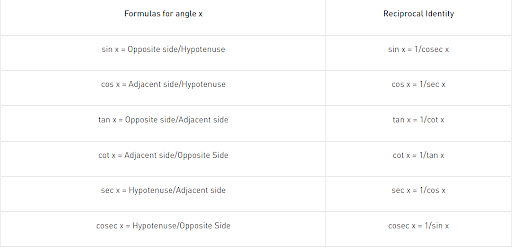If $\cos \, 3x \, \cos \, 2x \, \cos \, x = \frac{1}{4} $ and $0 < x < \frac{\pi}{4}$, then the value of $x$ is
- $\frac{\pi}{6}$
- $\frac{\pi}{5}$
- $\frac{\pi}{8}$
- $\frac{\pi}{7}$
The Correct Option is C
Solution and Explanation
$\Rightarrow 2\left(2\cos\, x\, \cos\,3x\right)\, \cos\, 2x=1$
$\Rightarrow 2\left(\cos\,4x + \cos\, 2x\right)\, \cos\, 2x=1$
$\left[\because 2\cos\, A\, \cos\, B-\cos\, B=\cos\left(A+B\right) + \cos\left(A-B\right)\right]$
$\Rightarrow 2\left(2\cos^{2}\, 2x-1 + \cos\, 2x\right)\, \cos\, 2x=1$
$\Rightarrow 4\, \cos^{3}\, 2x-2\cos\, 2x+2\cos^{2}\, 2x-1=0$
$\Rightarrow 2\cos\, 2x\left(2\cos^{2}\, 2x-1+1\left(2\cos^{2}\,x-1\right)\right)=0$
$\Rightarrow \left(2\cos^{2}\, 2x-1\right)\left(2\cos\,2x+1\right)=0$
$\Rightarrow \cos\,4x(2\cos\,2x + 1) = 0$
$\Rightarrow \cos\,4x=0$ or $2\cos\,2x + 1=0$
$\Rightarrow \cos\,4x =\cos \frac{\pi}{2}$ or $\cos\,2x=\frac{-1}{2}$
$\Rightarrow 4x=\frac{\pi}{2}$ or $\cos\,2x=\cos \frac{2\pi}{3}$
$\Rightarrow x=\frac{\pi}{8}$ or $2x=\frac{2\pi}{3}$
$\Rightarrow x=\frac{\pi}{8}$ or $x=\frac{\pi}{3}$
Since, $x \in\left(0, \frac{\pi}{4}\right)$
$\therefore x=\frac{\pi}{8}$ is the required value.
Top Questions on Trigonometric Functions
- The integral \[ \int_0^\pi \frac{8x}{4\cos^2 x + \sin^2 x} \, dx \text{ is equal to:} \]
- JEE Main - 2025
- Mathematics
- Trigonometric Functions
- The value of \( \cos \left( \sin^{-1} \left(-\frac{3}{5}\right) + \sin^{-1} \left(\frac{5}{13}\right) + \sin^{-1} \left(-\frac{33}{65}\right) \right) \) is:
- JEE Main - 2025
- Mathematics
- Trigonometric Functions
- If \( \alpha>\beta>\gamma>0 \), then the expression \[ \cot^{-1} \beta + \left( \frac{1 + \beta^2}{\alpha - \beta} \right) + \cot^{-1} \gamma + \left( \frac{1 + \gamma^2}{\beta - \gamma} \right) + \cot^{-1} \alpha + \left( \frac{1 + \alpha^2}{\gamma - \alpha} \right) \] is equal to:
- JEE Main - 2025
- Mathematics
- Trigonometric Functions
- Evaluate the limit: \[ \lim_{x \to 0} \csc{x} \left( \sqrt{2 \cos^2{x} + 3 \cos{x}} - \sqrt{\cos^2{x} + \sin{x} + 4} \right) \] is equal to:
- JEE Main - 2025
- Mathematics
- Trigonometric Functions
Let \( M \) and \( m \) respectively be the maximum and the minimum values of \( f(x) = \begin{vmatrix} 1 + \sin^2x & \cos^2x & 4\sin4x \\ \sin^2x & 1 + \cos^2x & 4\sin4x \\ \sin^2x & \cos^2x & 1 + 4\sin4x \end{vmatrix}, \quad x \in \mathbb{R} \) for \( x \in \mathbb{R} \). Then \( M^4 - m^4 \) is equal to:
- JEE Main - 2025
- Mathematics
- Trigonometric Functions
Questions Asked in UPSEE exam
- Which of the following carbohydrates are branched polymer of glucose
- UPSEE - 2019
- Carbohydrates
- The imaginary part of $\left( \frac{1}{2} + \frac{1}{2}i\right)^{10} $ is
- UPSEE - 2019
- Complex Numbers and Quadratic Equations
Acetic acid dissociates 1.3%. What will be the pH of \(\frac {N}{10}\) solution of the acid.
- UPSEE - 2019
- Acids and Bases
Let z = x + iy be a complex number satisfying the following equation |z - (2 + i)| = |Re(z) - 4 | Which of the following options describes the above equation?
- UPSEE - 2019
- Complex Numbers and Quadratic Equations
- Let $a_1, a_2, a_3$, ... be an arithmetic progression with nonzero common difference. It is given that $\sum^{12}_{i = 4} a_i = 63$ and $a_k = 7 $ for some k . Then the value of k is
- UPSEE - 2019
- Arithmetic Progression
Concepts Used:
Trigonometric Functions
The relationship between the sides and angles of a right-angle triangle is described by trigonometry functions, sometimes known as circular functions. These trigonometric functions derive the relationship between the angles and sides of a triangle. In trigonometry, there are three primary functions of sine (sin), cosine (cos), tangent (tan). The other three main functions can be derived from the primary functions as cotangent (cot), secant (sec), and cosecant (cosec).
Six Basic Trigonometric Functions:
- Sine Function: The ratio between the length of the opposite side of the triangle to the length of the hypotenuse of the triangle.
sin x = a/h
- Cosine Function: The ratio between the length of the adjacent side of the triangle to the length of the hypotenuse of the triangle.
cos x = b/h
- Tangent Function: The ratio between the length of the opposite side of the triangle to the adjacent side length.
tan x = a/b
Tan x can also be represented as sin x/cos x
- Secant Function: The reciprocal of the cosine function.
sec x = 1/cosx = h/b
- Cosecant Function: The reciprocal of the sine function.
cosec x = 1/sinx = h/a
- Cotangent Function: The reciprocal of the tangent function.
cot x = 1/tan x = b/a
Formulas of Trigonometric Functions:
